Our Verdict
Path of Exile was a great game in 2013, but a slew of free expansions have only made it better. It’s one of the best ARPGs out there, and absolutely the best value.
PC Gamer's got your back
We originally reviewed Path of Exile in 2013. It has changed significantly since then, so much so that we decided to review it again. Our original review can still be found here. For more about why we've chosen to re-review certain games, head here.
What is it? A huge free-to-play action-RPG
Expect to pay: Free-to-play, or up to $45 for some cosmetic armour sets
Developer: Grinding Gear Games
Publisher: Grinding Gear Games
Reviewed on: Intel i5-3570K @ 3.40 GHz, 16GB of RAM, GeForce GTX 970, Windows 10
Multiplayer? Yes
Link: Official site
When you wash up on the shores of Wraeclast in Path of Exile’s opening moments, you’re a pitiful sight, completely lost and clad only in tattered rags. Survival means hitting wandering, bloated cadavers with driftwood until they explode. Take some time to appreciate the simplicity. From there, Path of Exile piles on the complexity and scope, transforming you from a shipwreck survivor into a god-killing, universe-jumping crusader.
Path of Exile has always tried to stand apart from other modern ARPGs with its lore-soaked setting and daunting passive skill tree doing a lot of the heavy lifting. Since 2013, however, more and more has been heaped onto it, not just taking it in a different direction from, say, Diablo 3, but from the genre in general. It’s blessed with a unique identity—one that’s built on experimentation and constant evolution.
If you’ve dabbled in other dungeon-delving romps, you’ll be familiar with the pattern of heading out into the wilderness to loot and kill—left and right clicking and hitting hotbar keys to attack and cast spells, Diablo-style—mopping up quests and becoming ludicrously powerful. But Path of Exile is still full of all manner of surprises. You can build a monster zoo, create your own hideout, or start fresh in a temporary world with new rules and weird twists.
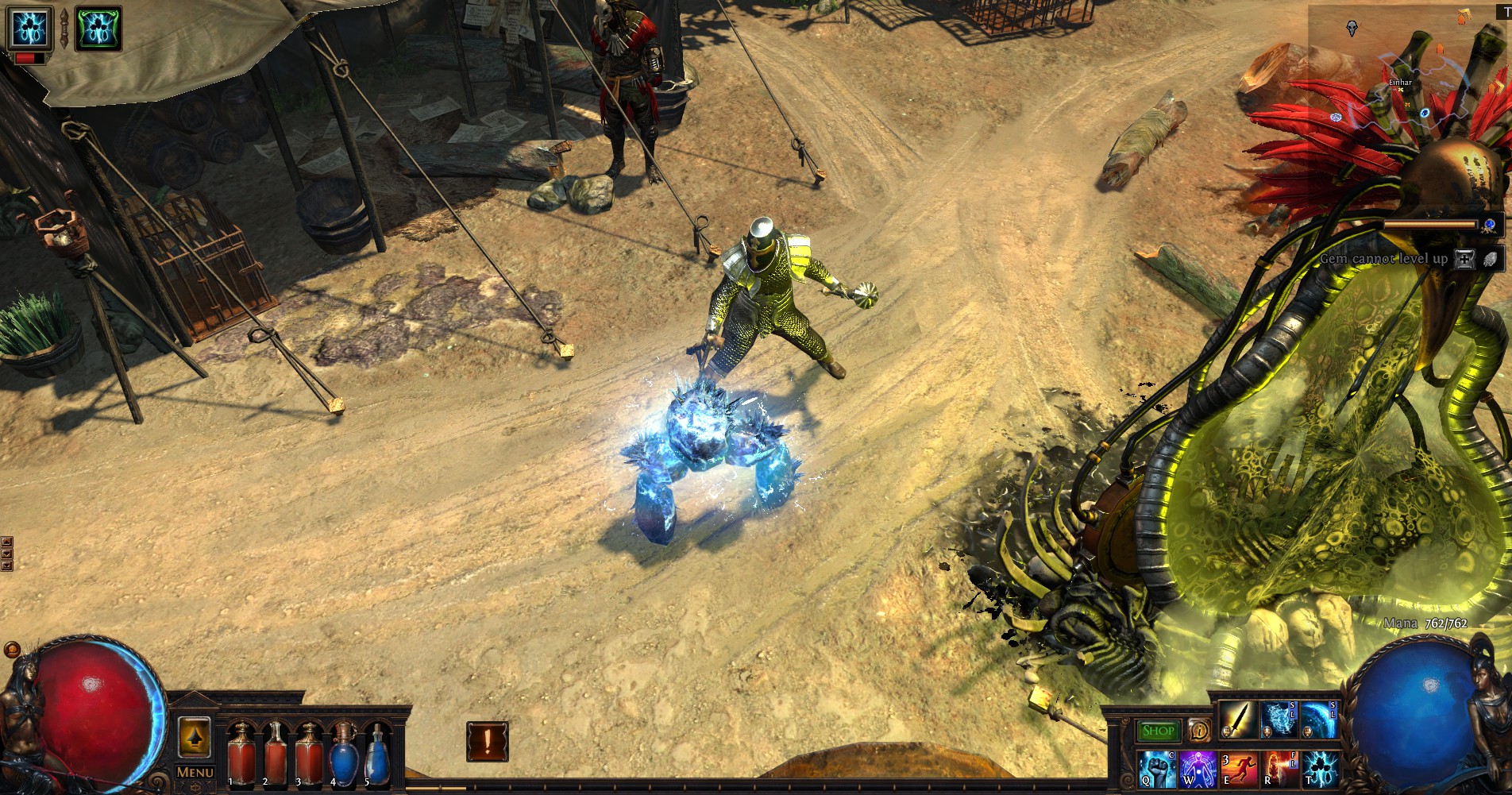
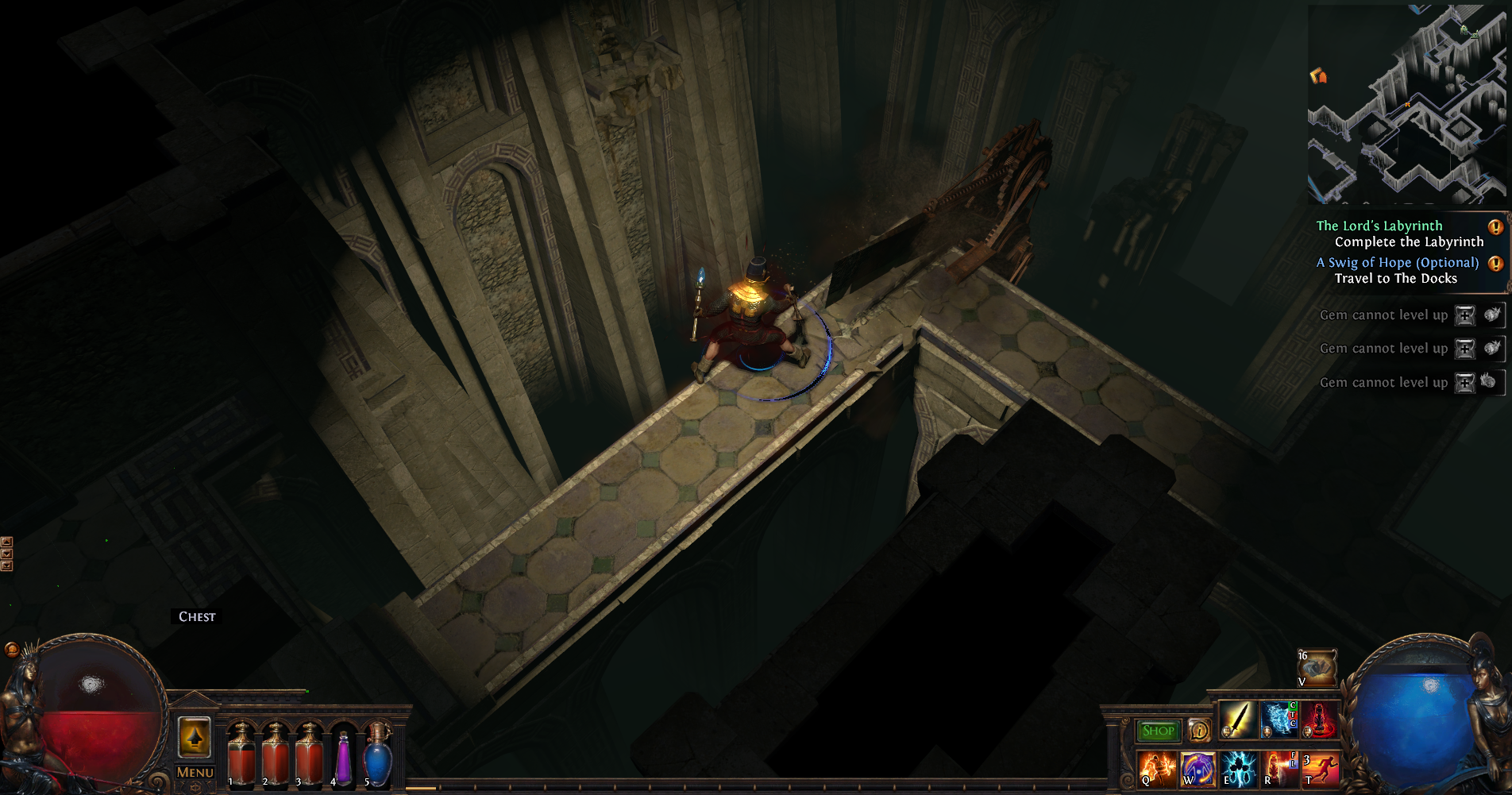
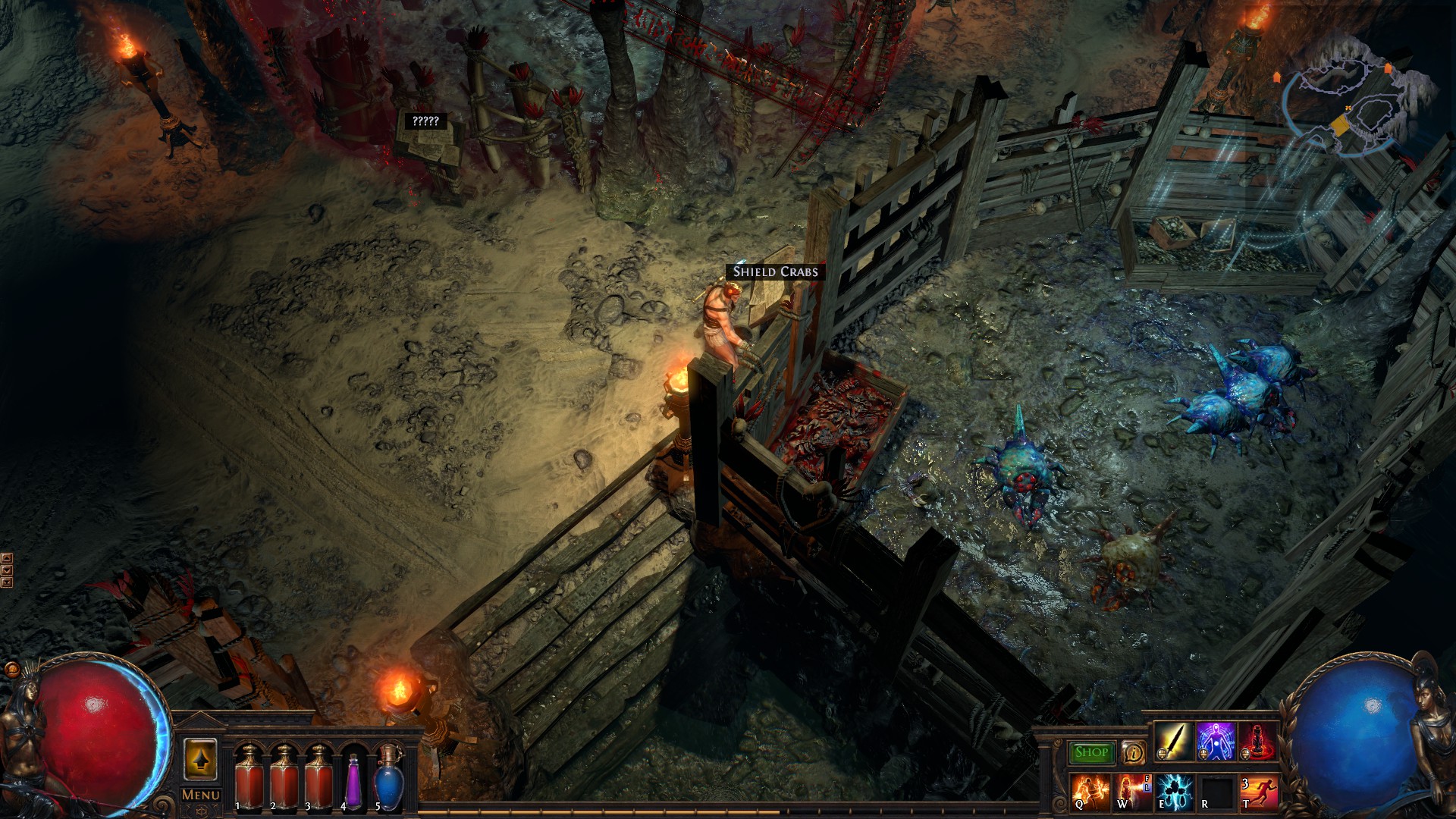
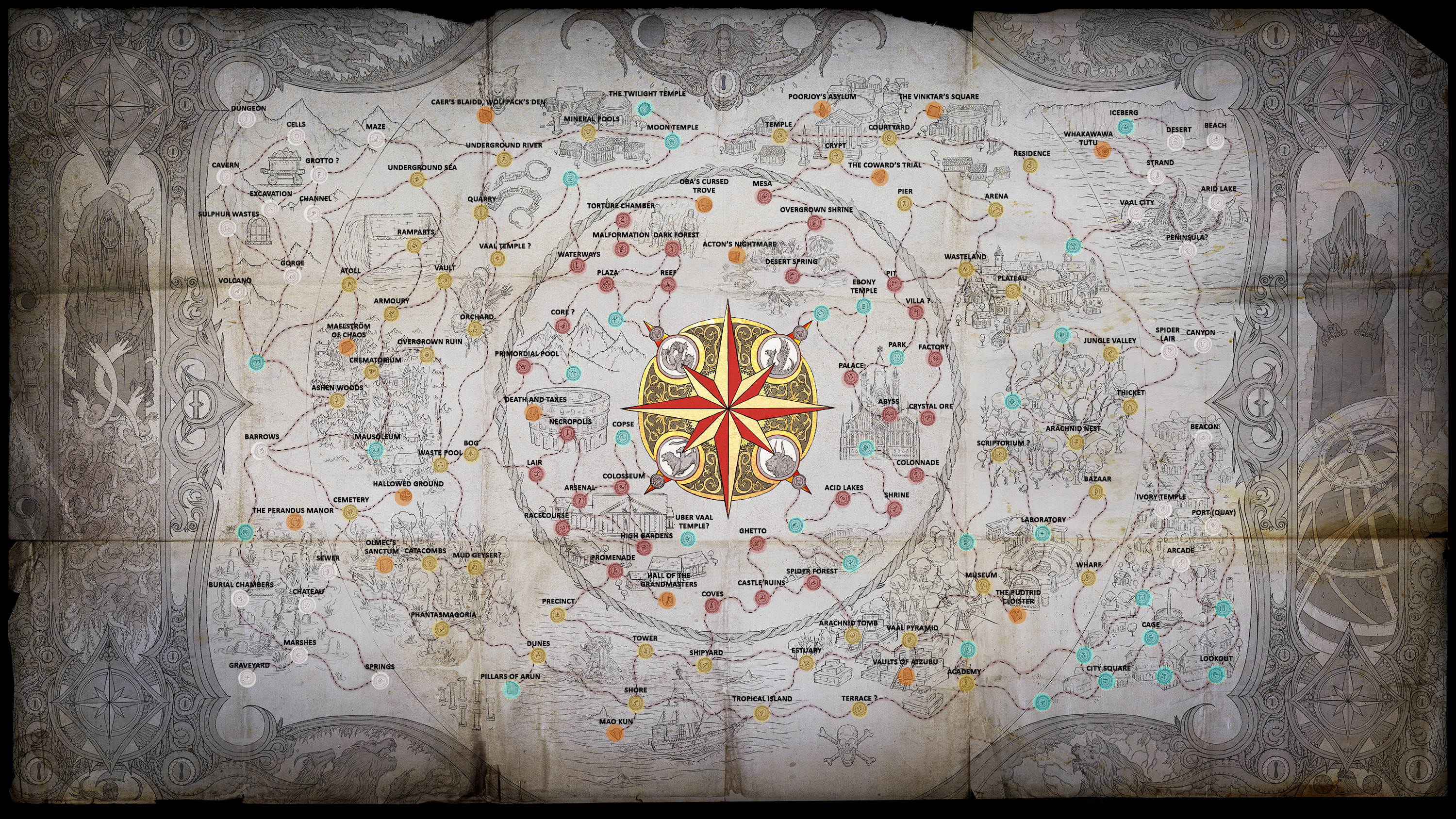
Just when you feel like you might be done with it, Path of Exile transforms, beckoning you to make the ascent again and again. This isn’t an RPG that’s comfortable with sitting still for long periods of time. There’s always a new boss to kill, a new system to wrap your head around, or a weapon that you absolutely must have for your new character build idea.
I get to just run around like a headless chicken, avoiding projectiles or getting swarmed by enemies, while my totems and the occasional summon do absolutely all the work.
It can be a lot to take in, but the heart of Path of Exile remains its character progression—that journey from nobody to cosmic superhero—and the absurdly huge passive skill tree that represents that growth. It’s a complicated web of passive abilities and stats that buff your Exile with additional dexterity, intelligence, weapon proficiencies, spell damage and countless other modifiers, broad and situational.
While you can pick from seven classes, like the tough Marauder or the hexy Witch, these determine where you begin on the web, not where you go once you start gaining new skill points. My Marauder might be a duel-wielding whirlwind of destruction, while yours could be an elemental shaman who uses magic more than brute strength, seeing you travelling across the skill tree in the opposite direction.
Exotic builds are Path of Exile’s bread and butter, and even after four years theorycrafters show no signs of slowing down. The builds have only gotten wilder since the introduction of Ascendancy classes: Every class gets three subclass options, aside from the Scion, who gets a special class that lets her draw from the skills of all the others. To get access to these high-tier powers, you’ll need to tackle a series of trials and dungeons that dole out Ascendancy points across the game.
These Ascendancy classes create focal points in an otherwise almost classless system, but they still maintain the level of freedom that makes creating an Exile so compelling. While the Ascendancy skill trees are much smaller than the mind-bogglingly huge passive skill tree you’ll normally use, they still offer up a multitude of paths for you to go down, even within a single subclass.
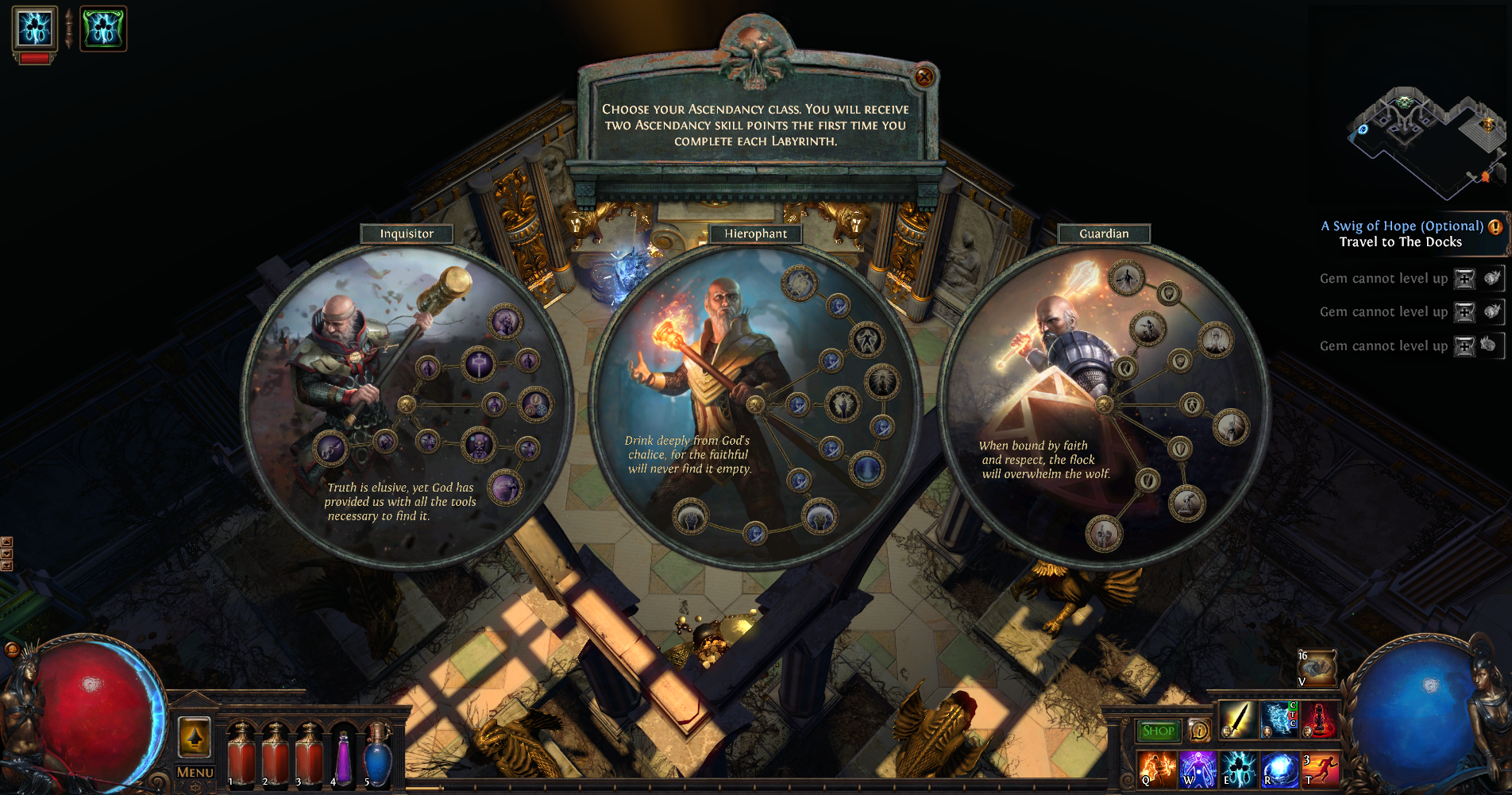
Keeping it classy
In my current run, I’ve been playing with a Hierophant, one of the Templar’s Ascendancy classes. It’s been a game-changer, letting me play with an almost pure-totem build. I get to just run around like a headless chicken, avoiding projectiles or getting swarmed by enemies, while my totems and the occasional summon do absolutely all the work.
It’s bizarre essentially being a bystander in these fights. I suspect the novelty will wear off, but fooling around with builds and trying to find one that fits you, if only temporarily, is one of Path of Exile’s great joys. There are countless builds to suit just about every playstyle, whether you want the simple pleasure of making shit explode with a hammer or the more abstract pleasure of raising an army of skeleton mages who obliterate everything in your path. There are even AFK builds that rely on damage reflection, letting you just stand there and watch enemies crumble.
While this does make an already daunting skill tree even more complicated, there are plenty of builds for new players, along with build walkthroughs, which go a long way to explaining Path of Exile’s elaborate but hard-to-parse progression systems. Steven has also put together a great list of starter builds created by Path of Exile boffins, which includes the the Hierophant build I’ve been using.
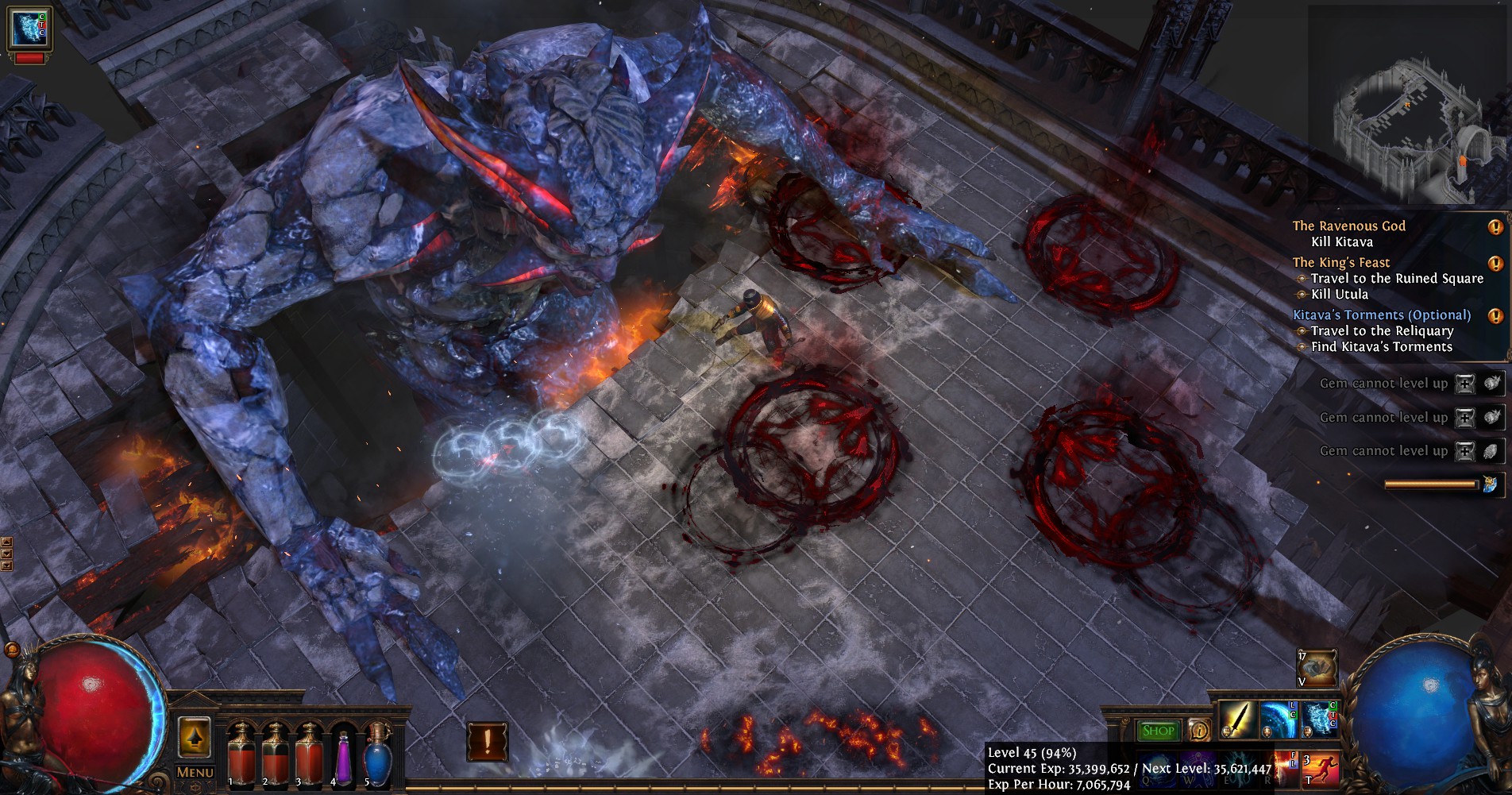
With the scope of the classes and subclasses being so huge, some suggestions or a recommended path would be valuable for new players. Other players do a fantastic job of serving as guides, but a lot of advice ends up conflicting, and even starter builds come full of jargon and the expectation that the reader has a decent handle on the basics. Path of Exile could maintain its openness while still nudging new players down a safe direction.
Once you do get to grips with it, you might find yourself cooling on every other RPG’s character progression. It never feels like a powerful skill that could dramatically change your character is too far away, and there are countless opportunities to tweak a build to significant effect. Jewel slots play a big part in this, allowing you to add physical jewels to specific nodes on the tree, conferring powerful bonuses. A single jewel can make a whole class come together, and you’ll be able to unlock slots and get your hands on them very early on.
Bejeweled
Path of Exile is a laboratory where you create terrifyingly powerful heroes before unleashing them on unsuspecting packs of monsters.
While we’re on the subject of glittering, shiny things, Path of Exile's skill gems are one of its most subversive designs. Because Path of Exile's classes aren't structured playstyles, there are no preordained abilities given to each one. Instead, looted skill gems are where you get your active abilities—assuming you meet their stat requirements. To use a skill gem, you have to place them in item sockets of the corresponding colour. Some items won’t contain any sockets, while higher level items can have six—making them exceedingly rare.
In a way, skill gems are like a form of spell crafting. If the sockets on an item are linked, you can slot multiple gems together and they'll share each other's effects. My Hierophant creates totems, for example, by combining a spell with the Spell Totem Support gem. Now, instead of casting a fireball with my hand, I create a totem that does it for me so I can focus on not getting impaled by a demon. More links mean more possibilities, letting you create all sorts of brand new spells with increasingly complicated synergies. There’s something pleasingly tactile about it, too, like you’re constructing spells by hand.
Eventually you’ll be a one-person apocalypse, and the spell effects look the part, liberally filling the screen with magic and destruction. Path of Exile is a laboratory where you create terrifyingly powerful heroes before unleashing them on unsuspecting packs of monsters, essentially. The poor things. They can put up a pretty good fight at times, however. And Path of Exile's toughest bosses are more akin to bullet hell shoot 'em ups than classic RPGs.
From exile to archeologist
The 10-act journey (it launched with only 3) is a gothic romp that will see you dive into the history of the world like a heavily-armoured archaeologist. Before you know it, you’ll be pit against demons, gods, and eventually entities fighting over a multiverse of dream worlds. It gives even the gratuitous God of War series a run for its money.
The thirst for new gear is one of Path of Exile’s most obvious driving forces. There are a bewildering number of stats and special item powers to consider when decking out your Exile, and your inventory will always be overflowing with options, though often not very good ones. It can frequently be a case of quantity over quality, with RNG making it even harder to get decent gear.
There are ways to bypass that, though. You can augment and transform items, trade collectible divination cards for unique gear, dabble in some crafting—they all give you a bit more control. Then there’s the trade system, a whole bartering economy based on various commodities in lieu of a single currency (Path of Exile has no standard money, like gold). It used to be that players had to trade directly with each other or use third-party sites, but Grinding Gear recently created a trade hub. It lists items and shows if sellers are offline or AFK, ostensibly making it easier to get in touch, which you can also do via the hub.
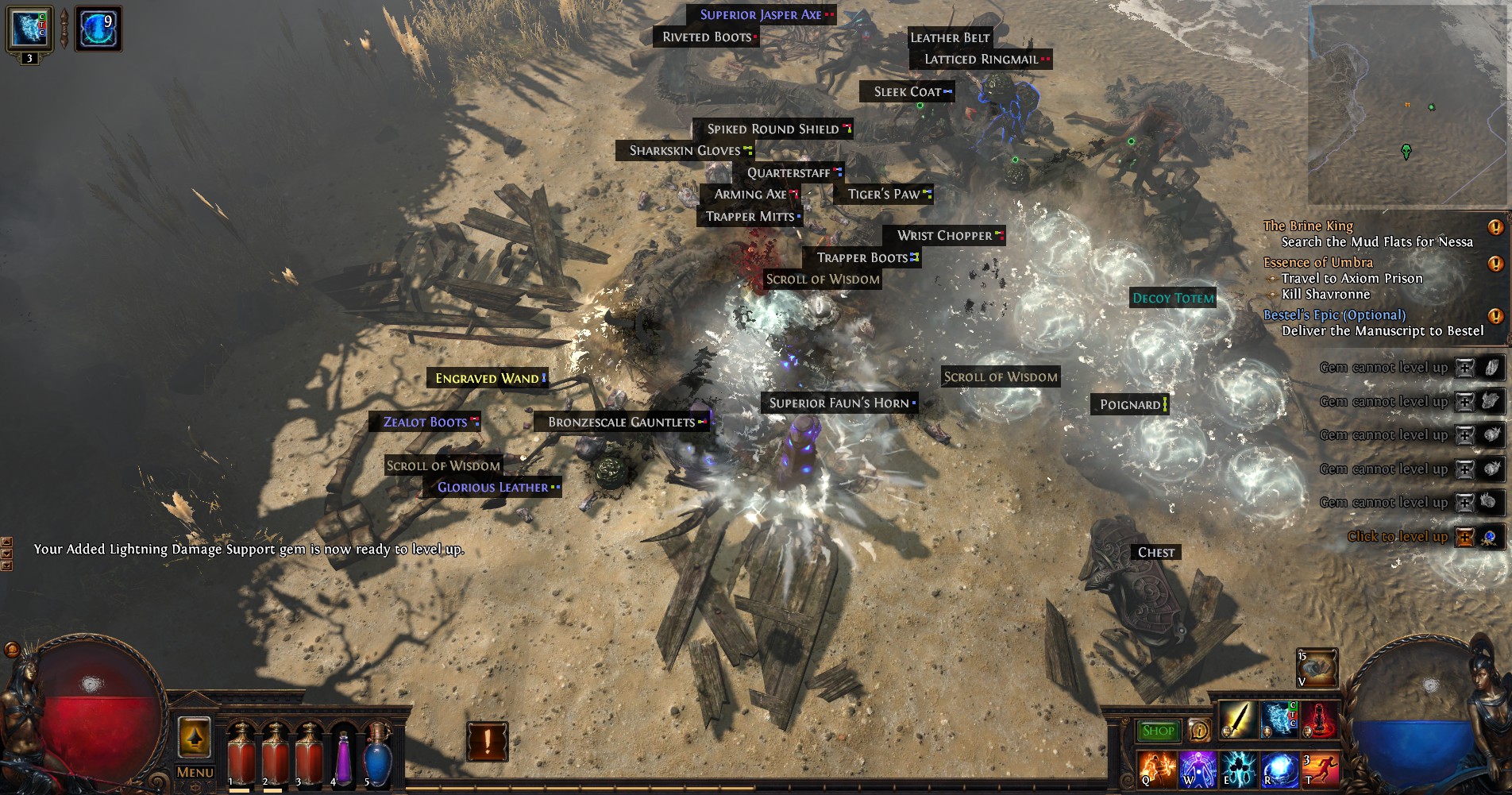
It’s still a bit of a hassle, but I actually like the slight inconvenience. With an auction house where I can get what I want at the touch of a button, I might as well just be dealing with an NPC shop. It’s faceless and absent any human interaction. And since I have to make an actual effort to trade, I’m not doing it all the time—I’m getting stuck into the game and upgrading my gear on my own.
Touring the multiverse
As you approach Path of Exile’s final acts, you’ll start to get access to the Atlas of Worlds, the endgame. By discovering magical maps, you can enter dream worlds—essentially random dungeons—and fight across a dreamscape multiverse, netting you increasingly more powerful items and toughening you up enough to murder your way through maps of higher tiers.
It ends the division that used to exist between the acts and the endgame. There’s a sense of cohesion that wasn’t present before, making it feel like a sprawling eleventh act. It doesn’t feel like you’re in the waiting room, twiddling your thumbs while Grinding Gear works on the next update—there’s a whole war between two factions to become embroiled in, full of unique monsters and loot. And there are still plenty of reasons to go back and run through the rest of the game.
While Leagues are temporary, they also serve as testbeds for experimentation, introducing new features that become mainstays.
Path of Exile’s most effective trick for getting players to start their whole journey over again is the League system. Along with the Standard and Hardcore versions—the vanilla game without and with permadeath, respectively—there are special temporary Leagues that dramatically transform the game, sometimes to the point of reinvention.
The latest, the Bestiary League, puts a Pokémon and Monster Hunter spin on things, giving players the ability to capture monsters in the wilderness. These captured beasties get stored in a handy menagerie that you can teleport to via the mysterious NPC who runs the place. You can head there to visit your new best friends, or you can ritually murder them for loot. Want a new pair of shoes or a mod for your healing flask? Kill some critters!
The extent of the transformation varies from League to League, though the changes are always hard to miss. They’ve ranged from undead criminals that hound players, to cracks opening up in the ground, spewing out hordes of nasty abyssal creatures. And while the Leagues are temporary, they also serve as testbeds for experimentation, introducing new features that become mainstays.
Free for real
In our original review, Tom called the free-to-play model “wonderfully generous,” and it’s only become more generous since launch. Not one expansion or feature costs money, while the in-game shop’s only item that isn’t purely cosmetic just expands the size of your already large stash. If you don’t want to spend a dime, there are few games that offer this much.
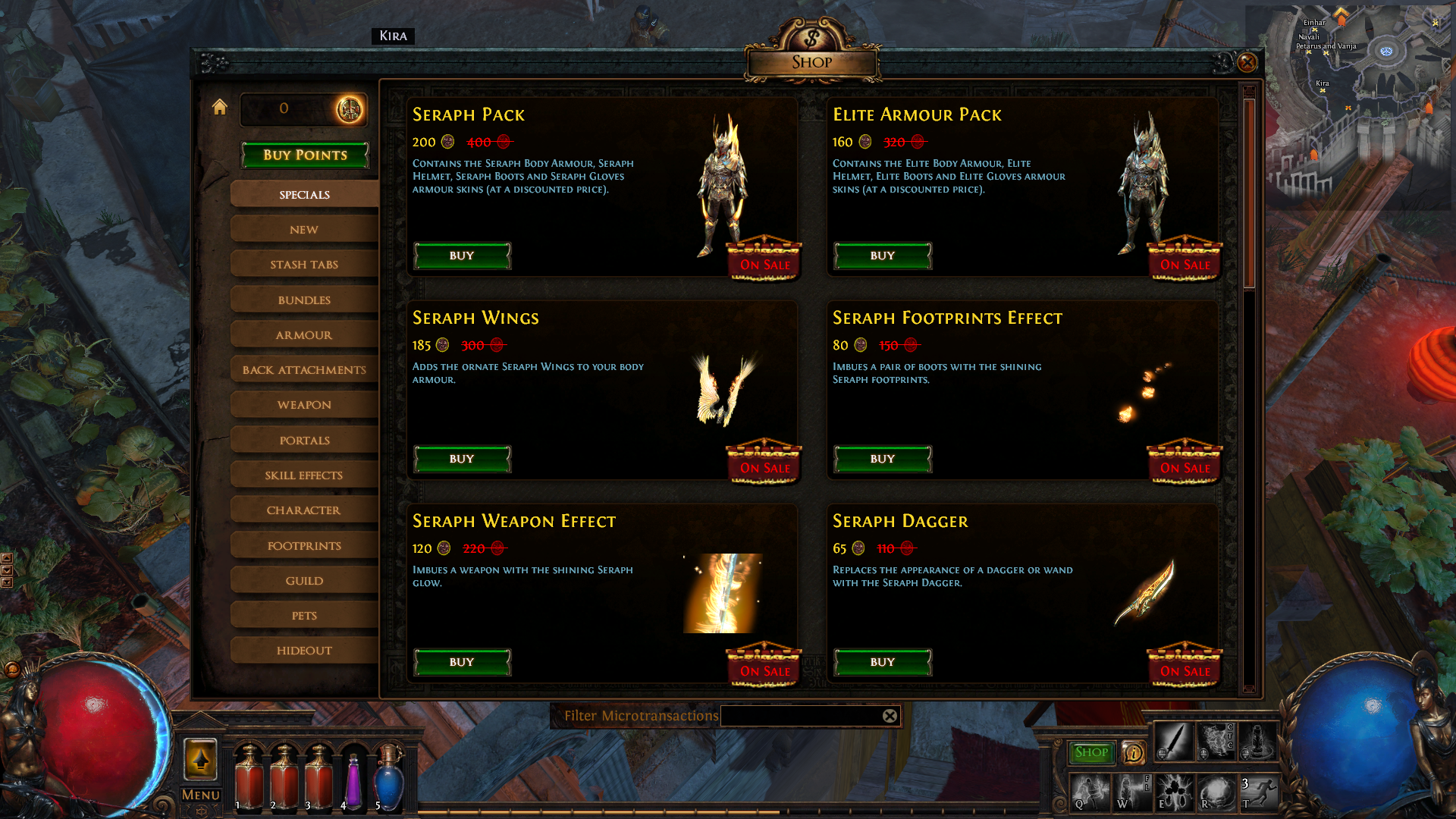
While free players are very well catered to, those willing to part with their cash might be a bit more disappointed. Cosmetic armour sets, for instance, can set you back as much as $45, though you can usually find a couple of sets on sale for around $20. If you just want a bit of flair, however, like an ominous glow, those are often around $10. Though pricey, it’s comparable to other microtransaction shops, but given the excellent value elsewhere in Path of Exile, it’s a shame you can’t get more bang for your buck here.
Coming back to Path of Exile after only a year away, let alone four, can be a bewildering experience. For all its new systems and fleeting Leagues, however, it’s still a game about storming dungeons and unleashing apocalyptic spells and attacks on entire armies, all in the name of getting more lovely loot. That’s what all these extra features applied over years of updates have been supporting, and they’ve only made it better.
Path of Exile was a great game in 2013, but a slew of free expansions have only made it better. It’s one of the best ARPGs out there, and absolutely the best value.

Fraser is the UK online editor and has actually met The Internet in person. With over a decade of experience, he's been around the block a few times, serving as a freelancer, news editor and prolific reviewer. Strategy games have been a 30-year-long obsession, from tiny RTSs to sprawling political sims, and he never turns down the chance to rave about Total War or Crusader Kings. He's also been known to set up shop in the latest MMO and likes to wind down with an endlessly deep, systemic RPG. These days, when he's not editing, he can usually be found writing features that are 1,000 words too long or talking about his dog.


